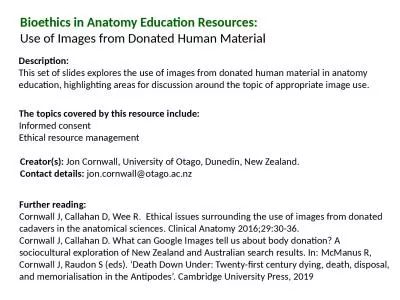PPT-Shifting images of the human body.
Author : tatiana-dople | Published Date : 2016-05-14
Year 11 VA Miss Tran The Frames Willendorf VS De Milo Artist Unknown The Venus of Willendorf 28000 25000 BCE Austria carved from oolitic limestone Alexandros
Presentation Embed Code
Download Presentation
Download Presentation The PPT/PDF document "Shifting images of the human body." is the property of its rightful owner. Permission is granted to download and print the materials on this website for personal, non-commercial use only, and to display it on your personal computer provided you do not modify the materials and that you retain all copyright notices contained in the materials. By downloading content from our website, you accept the terms of this agreement.
Shifting images of the human body.: Transcript
Year 11 VA Miss Tran The Frames Willendorf VS De Milo Artist Unknown The Venus of Willendorf 28000 25000 BCE Austria carved from oolitic limestone Alexandros of Antioch Venus de Milo Aphrodite 130100BC . Book Reviews: Shifting Involvements: Private Interest and Public ActionPage 2 of 3http://www.politicalreviewnet.com/polrev/reviews/CONS/R_1351_0487_046_1005623.aspWhen a recently acquired kitchen or c hippocampal. circuits. M. . Meeter. J. M. J. . Murre. L. M. . Talamini. Date of Presentation: 05/09/2012. Introduction. Role of Acetylcholine. in Mode Shifting. Hippocampal. novelty detection may regulate levels of acetylcholine. ALA Midwinter, January 27, 2014. OCLC Research Update. Lynn Silipigni Connaway, Ph.D.. Senior Research Scientist. OCLC. connawal@oclc.org. @LynnConnaway. Ixchel M. Faniel, Ph.D.. Associate. Research Scientist. Only 29% of Millennials Cite Ad Skipping as Their Primary Reason . Top Reasons For Time-shifting TV Shows. Source: . HUB Entertainment research; Survey of 1210 . tV. consumers 16-74 who watch at least 5 hours of . Making Room for Growth. 10/10/2008. By Elizabeth Jones: ejones@okcu.edu. Why we needed a . LARGE Scale . Shift?. 7,569 Gift Items.. 1,817 New Items.. Re-Shelving Issues.. Top & Bottom Shelves were full.. Top Reasons For Time-shifting TV Shows. Source: HUB Entertainment research 3/15; Survey of 1210 . tV. consumers 16-74 who watch at least 5 hours of . tv. /week and have broadband home access; What do you consider to be the biggest benefits of watching episodes of a current show at a later time?. HEADLINE. Body. text,. body text, body text, body text, body text, body text, body text, body text, body text, body text, body text, body text, body text, body text, body text, body text, body text, body text, body text, body text, body text. Susan . Teubner. -Rhodes, Kenneth I. . Vaden. Jr., Lois Matthews, Judy R. . Dubno. , & Mark A. Eckert. Aging and Speech Recognition. Older adults have difficulty understanding speech in background noise. Spread. An . update on risk shifting and risk . distribution. Paul Philips. EY. Partner. Hugh Tollack. Rent A Center, Inc.. Director of Tax Audits, Research and Planning. AGENDA. Historical view of risk shifting & risk distribution. Partners in Activism . Educators. ’ Guide. Aaron Douglas and . Arna. Bontemps: Partners in Activism. The . Day-Breakers. By . Arna. Bontemps. We are not come to wage a strife. With swords upon this hill,. La gamme de thé MORPHEE vise toute générations recherchant le sommeil paisible tant désiré et non procuré par tout types de médicaments. Essentiellement composé de feuille de morphine, ce thé vous assurera d’un rétablissement digne d’un voyage sur . An MRI Machine. I. Computerized Axial Tomography (CAT/CT). CT scanning adds . many X-ray . images with the aid of a computer to generate cross-sectional views of a patient's anatomy.. CT scans are performed to analyze the internal structures of various parts of the . Computer Science. Columbia University. Supported by. : . NSF. . and ONR. Structured Light 3D Scanning. Defect Inspection. Wafer defect. Gaming. Archiving Heritage. Biometrics. Shape from Structured Light. The topics covered by this resource include:. Informed consent. Ethical resource management. Further reading:. Cornwall J, Callahan D, Wee R. . Ethical issues surrounding the use of images from donated cadavers in the anatomical sciences.
Download Document
Here is the link to download the presentation.
"Shifting images of the human body."The content belongs to its owner. You may download and print it for personal use, without modification, and keep all copyright notices. By downloading, you agree to these terms.
Related Documents














